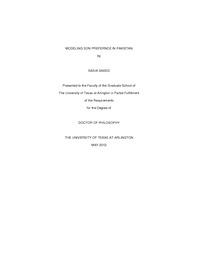| dc.description.abstract | Gender has become one of the most politicized issues in South Asian countries over the past 100 years. They were expected to cook for the family, clean the house, feed their children, look after all family members, and give birth to a male child. When a woman gave birth to a male child she was considered very respectable in the family. Son preference is one of the oldest issues in most societies, with males given preferential treatment over females. In spite of the rapid advancement in education and communication, the desire for a son continues to remain (NIPS, 1992). Sons are usually preferred as they are considered a symbol of prestige for their families. Sons, not daughters, carry the family name and keep the family intact. This is one reason women are pressured to continue to give birth until they deliver a boy. In Pakistan discrimination against the girl child is a function of cultural and economic factors. In a culture where son preference exists, scarcity of resources may heighten the discrimination against females. The objective of this study of son preference is to investigate the effects of social structural factors, such as type of place (Urban, Rural), family type (extended or non-extended), women education, agricultural and non agricultural households, inter-cousin marriages, sex composition of surviving children, husband's level of education, and age at marriage. Finally, I investigated the effect of changes in social structural factors on changes in son preference behavior in Pakistan. Data for this study are from Pakistan Demographic and Health Survey (PDHS) 1990-1991 and 2006-2007. Both surveys cover the entire country and provide sufficient information about family structure, fertility trends, socio-economic background, literacy level and respondent's attitude toward son preference. The analysis was conducted by using secondary data. This study used the Pakistan Demographic and Health Survey (PDHS) conducted in 1991-1992 and 2006-2007 as a source of data. The PDHS collects a wide range of data about population and health issues and includes questions regarding gender preference for children in 1992. The PDHS 1990-1991 and 2006-2007 provides information about population characteristics such as (1) urban and rural background of the respondents, (2) educational level of husband and wife, (3) age difference between husband and wife at the time of marriage, (4) age of female at the time of marriage, (5) family size preference, (6) Agricultural and non agricultural background, and (7) type of family. The universe is four provinces of Pakistan. . For the 1991-1992 survey a total of 6,611 households were selected for the women's sample. The target was ever-married women, ages 15-49. Sample size of 10,023 respondents is married women, ages 15-49. Four provinces of Pakistan are included in the sample. The dependent variable in this study is son preference. In this study type of place, type of family, women educational level, age difference between husband and wife, agricultural and non agricultural households and inter-cousin marriages have been selected as the predictive variables while region, (Punjab, Sindh, NWF), sexcomposition of surviving children and husband education constitute the control variables. This research has found that son preference has increased in Pakistan during 1990 to 2007. Almost 10% increase in son preference can be seen in Pakistan between 1990 until 2007. In 1990-1991 son preference ratio was 38.3% and increased in 2006-2007 to 47.5%. The phi-coefficient measures the degree of association between dichotomous variables in the study. The phi-coefficient indicates that there is a significant compositional change in almost all the variables since 1991-2007, but the magnitude of that association is very weak. Decomposition of variables indicates that almost all changes with respect to son preference in the population are due to affect changes in variables rather than compositional changes during 1991-2007. Though there is an increase in son preference behavior in Pakistan in last 15 years, this increase is not uniform across all population sub-groups. The study found that among urban, educated and non-agricultural household women, the son -preference was significantly lower than the rest. But the magnitude of this change is very low and the proportion of that population is very small. That is the reason they have not had a larger impact in terms of reducing son preference. This study will help to improve gender discrimination in Pakistan. This research can also provide guidelines for economic policymakers to introduce such policies that create more earning opportunities for females, because it is observed that household wealth decreases son preference (Seker & Hatti, 2010). This research will provide guidance to social workers to start programs that create mass awareness among people with special emphasis on cultural misconceptions. This study also severs as road sign for further research in this area and can therefore be replicated. | en_US |


